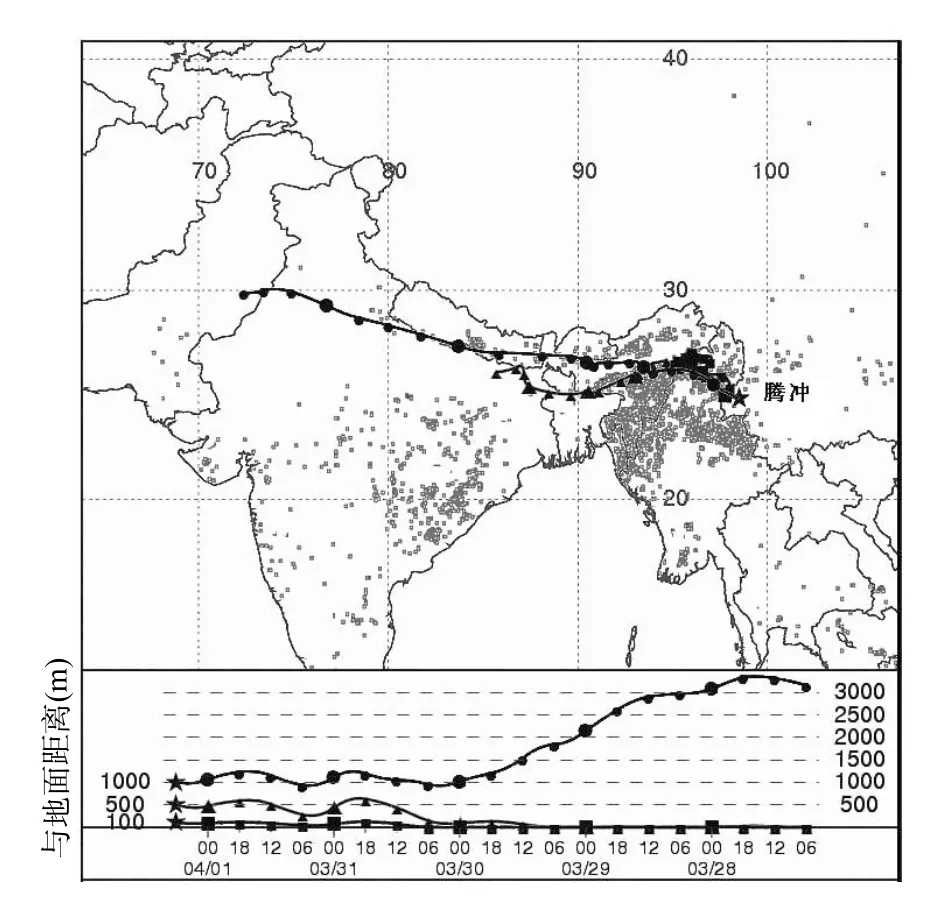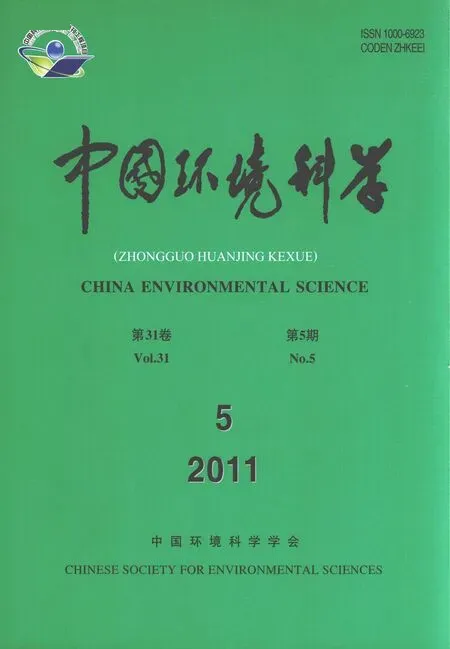我国腾冲大气PAHs的可能来源分析
徐 玥,赵 斌,刘东廷,刘 向,李 军*,张 干 (.中国科学院广州地球化学研究所,有机地球化学国家重点实验室,广东 广州 50640;2.中国科学院研究生院,北京 00049;.云南省腾冲县气象局,云南 腾冲 67900)
我国腾冲大气PAHs的可能来源分析
徐 玥1,2,赵 斌3,刘东廷3,刘 向1,李 军1*,张 干1(1.中国科学院广州地球化学研究所,有机地球化学国家重点实验室,广东 广州 510640;2.中国科学院研究生院,北京 100049;3.云南省腾冲县气象局,云南 腾冲 679100)
2005年10月22日至2006年10月21日,在云南腾冲一典型背景点进行了每周一次的大气采样,以监测季风期东南亚地区生物质燃烧导致的多环芳烃(PAHs)的输入状况.结果表明,监测期内总 PAHs含量为 43.1~156ng/m3(平均值为 87.9ng/m3).其中气相 PAHs均值为85.8ng/m3,无明显的季节变化;颗粒相PAHs均值为2.35ng/m3,在春季出现显著高值,可能与东南亚生物质燃烧释放的PAHs在南亚季风作用下向腾冲的跨境迁移有关.颗粒相PAHs以毒害性较大的高环PAHs化合物为主,其在偏远地区生态系统中的累积可能带来一定的生态风险.关键词:腾冲;多环芳烃;大气迁移;东南亚生物质燃烧
多环芳烃(PAHs)主要来源于化石和生物质燃料的不完全燃烧,因其 “三致”作用受到广泛关注和立法限制.英国空气质量专家组早在1999年就将空气中苯并[a]芘限值定为 0.25ng/m3[1].大气中的PAHs半衰期为 1~7d[2],能同时以气相和颗粒相的形态发生长距离迁移.有研究报道我国部分地区大气PAHs向境外的输出[3-4],但是针对境外大气PAHs向我国输入的报道还较少.
生物质燃烧是大气PAHs的重要来源之一.东南亚森林大火集中在春季[5],已有研究证实南亚季风能将其间释放的臭氧、细颗粒等输送到香港等地[6].在适合的气象条件下,燃烧产生的PAHs也很可能向我国西南地区发生迁移.本研究选取毗邻东南亚的云南腾冲一区域背景点,观测大气中PAHs的含量特征和季节变化,探讨可能的大气PAHs跨境迁移对该地区大气环境的影响.
1 材料与方法
1.1 样品采集
采样点设于云南省腾冲县背景点山顶(24.95°N, 98.48°E, 海拔 1960m)空旷地,与腾冲县城相距约 10km,周围人类活动较少,采样期间无明显人为干扰.
2005年10月22日至2006年10月21日,利用用大流量采样器每隔6d采集24h大气样品,每次采集大气约 400m3.分别使用石英滤膜(Grade GF/A,20.3cm×25.4cm, Whatman, Maidstone, England)和串接的聚氨酯塑料泡沫收集大气颗粒物及气相污染物样品.采样前将石英滤膜预先在450℃的马弗炉中灼烧4h,PUF体积比1:1的丙酮-二氯甲烷混合液净化,采样后密封于-18°C保存.
1.2 PAHs分析
样品中加入二氢苊-d10、菲-d10、-d12、苝-d12作为回收率指示物,二氯甲烷索氏抽提 24h.浓缩后的提取液通过依次装有无水硫酸钠、中性硅胶、中性氧化铝的层析柱,用体积比1:1的正己烷-二氯甲烷混合液洗脱PAHs组分,再加入内标物六甲基苯,以安捷伦7890气相色谱-5975质谱联用仪测定15种优控PAHs(苊(Acey)、二氢苊(Ace)、芴(Flu)、菲(Phe)、蒽(Ant)、荧蒽(Flur)、芘(Pyr)、苯并[a]蒽(BaA)、(Chr)、苯并[b]荧蒽(BbF)、苯并[k]荧蒽(BkF)、苯并[a]芘(BaP)、茚并[1,2,3-c,d]芘(Ind)、二苯并[a,h]蒽(diB)、苯并[ghi]苝(BghiP))含量.
1.3 质量保证和质量控制(QA/QC)
实验过程中以多环芳烃标样控制仪器偏差在±10%以内.样品中二氢苊-d10、菲-d10、-d12、苝-d12的回收率分别为 71.0% ±11.5%,77.5% ±12.3%,91.2% ± 18.2% 和 97.6% ± 22.1%.实验室空白和野外采样空白中目标化合物含量低于检测限或小于样品含量的5%(芴、菲、蒽).测得数据未经回收率校正.
1.4 气流轨迹分析
为分析气流来源,本研究中采用了NOAA网站 (National Oceanic and Atmospheric Administration)公布的气流轨迹分析软件Hybrid-Single Particle Integrated Trajectories (HYSPLIT 4.8),分别在采样开始的 6,12,18,24h时计算距离地面高度为100,500,1000m位置的120h后推气流轨迹.
2 结果与讨论
2.1 含量水平和组成特征
本实验鉴定的 15种 PAHs总含量在43.1~156ng/m3范围(平均 87.9ng/m3).气相PAHs总量在40.9~155ng/m3范围,均值为85.8ng/m3.颗粒相中 PAHs浓度为 0.06~16.6ng/m3,均值2.35ng/m3.虽然同属背景站点,腾冲的PAHs含量显著高于世界其他背景点或乡村地区,如苏必利尔湖(2.5~6.3ng/m3)[7],欧洲高山地区(1.3~2.6ng/m3)[8],乞沙比克湾(2.7~5.3ng/m3)[9],青海瓦里关(7.4~30.0ng/m3)[10].表 1说明在云南,即使是相对远离人类活动的站点,也受到区域大气中高含量PAHs的影响.
总PAHs以气相PAHs为主,约占96%.检出的15种优控PAHs在气相和颗粒相中具体含量见表1.

表1 腾冲大气中PAHs在气相和颗粒相中浓度Table 1 Concentrations of PAHs in gas and particle phases at Tengchong Mountain
气相PAHs主要由低环化合物构成,其中菲,芴,蒽,荧蒽,芘的含量远高于其他PAHs,约占90%以上,高环化合物则大多低于检测限,仅在少部分样品中检出.相比之下,高环PAHs挥发性低,更易存在于颗粒相中.因此,颗粒相中3-、4-、5-、6-环 PAHs分别平均占总量的 36%,35%,14%和14%,以苯并[a]芘、苯并[k]荧蒽和茚并[1,2,3-c,d]芘含量较高.
2.2 季节变化
图1为2005-10-22至2006-10-21期间每次采样测得的PAHs含量.如图1所示,采样期间气相PAHs总体含量高,无明显季节变化规律.相反,颗粒相PAHs的季节变化趋势较明显,1~4月浓度相对较高,5~10月相对较低.

图1 气相和颗粒相中总PAHs浓度的季节变化Fig.1 The temporal variations of total PAHs in gas and particle phases
控制PAHs季节变化的因素很多.气相PAHs浓度与 Clausius-Clapeyron方程的符合度,可在一定程度上用以判识PAHs是否受控于本地温度作用的挥发过程[11].腾冲大气气相中所有 PAHs化合物与温度无显著相关性(P>0.05)或相关性较低(R2<0.17),可见气态 PAHs的季节变化受原地地表-大气交换作用的影响较小,可能更多地来自外源输入.
对于颗粒相 PAHs,干湿沉降和污染源排放对季节变化的影响较大.出现高含量的春季是干季,降水清除对颗粒物清除的影响作用不大,这期间来自印度缅甸地区的季风经过腾冲地区,可能带来该方向的PAHs污染.在前期研究中[12],发现了与实验期间同时采集的颗粒物样品中元素碳(EC)高值,出现在2006年的3~4月,受控于东南亚生物质燃烧污染物扩散.本研究中,颗粒相中PAHs除苯并[k]荧蒽和苯并[b]荧蒽以外,其他化合物含量均与 EC有不同程度的显著相关关系(P<0.05,R2=0.12~0.46),表明春季颗粒相PAHs也可能受相同的事件作用.5~10月季风同样来自印度和缅甸方向,但这段时间是云南的雨季,降水能有效地清除颗粒物,从而显著降低颗粒相中PAHs的总量.此后冬季气流主要来自中国南方地区,同时降水少,颗粒相PAHs含量仍略高于雨季,但低于春季.
2.3 东南亚生物质燃烧对腾冲大气的影响
如前所述,颗粒相PAHs与EC的相关性提示了东南亚生物质燃烧对腾冲大气 PAHs的影响.研究表明[13],云南省 PAHs大多来源于薪柴的燃烧. 此外,采样期间菲/(菲+蒽),荧蒽/(荧蒽+芘)和茚并[1,2,3-c,d]芘/(茚并[1,2,3-c,d]芘+苯并[ghi]苝)比也处在文献报道的木材和灌木燃烧值范围以内,分别为0.81±0.02,0.63±0.02和0.75±0.03.虽然基于比值的 PAHs源解析可能会有一定局限性
[14],但多种化合物的比值都在同一类污染源范围,综合显示腾冲大气中的 PAHs主要为生物质燃烧成因.卫星火点图(http://firefly.geog.umd. edu/firemap/)也显示春季东南亚火灾严重,尤其在与云南接壤的缅甸地区火点几乎覆盖全境.2006年4月东南亚地区的气溶胶光学厚度明显高于周围其他区域(http://ladsweb.nascom. nasa.gov/browse_images/),这一时期生物质燃烧很可能引起大量 PAHs随颗粒物一起释放.经Hysplit气流轨迹分析发现,受到南亚季风影响,同一时期气流经印度、东南亚、最后进入腾冲,燃烧释放的 PAHs也会被带入中国西南地区.以2006年4月1日为例,图2为气流轨迹叠加火点图.可以看出气流经过缅甸境内然后到达腾冲,同时颗粒相中PAHs含量出现高值(图1).这期间几乎所有 PAHs在颗粒相上都呈上升趋势,即使是半衰期很短的 PAHs,如芴[15].已有研究证实吸收或吸附于颗粒物上的 PAHs寿命将会延长[16].南亚季风利于污染物向东转移,这意味着在春季特殊的气象条件下,生物质燃烧产生的 PAHs更可能迁移到远离源区的下风向位置,加剧污染传输.尤其是颗粒相中高环 PAHs致癌性较强[17],带来的生态风险也高.
生物质燃烧可以同时释放气态和颗粒态污染物[18],但腾冲气相PAHs并未在春季明显增加,可能与多方面因素有关.气相PAHs以易降解、易挥发的低环化合物为主.腾冲紫外辐射从11月到次年3月最高[19],脱离颗粒物的气相PAHs更容易降解.雨季气温较高,有更多的PAHs通过地表挥发进入大气.这种降解作用和局地地-气交换作用等过程的共同作用,可能导致东南亚生物质燃烧 PAHs大气传输的信息被掩盖.而颗粒相PAHs以不易挥发的高环化合物为主,受控因素不同,故长距离迁移特征更明显.

图2 2006年4月1日气流轨迹图(NOAA HYSPLIT模型计算)Fig.2 The back trajectories at Tengchong Mountain on April 1st, 2006 (generated by NOAA HYSPLIT model)
3 结论
3.1 云南腾冲地区大气中PAHs总含量在43.1~156ng/m3范围,高于世界其他背景点,其中气相PAHs在浓度上占优势,约占总PAHs的96%.
3.2 观测期间腾冲地区气相 PAHs无明显季节变化,而颗粒相中PAHs的季节性高值更多.可能与东南亚季风期生物质燃烧有关.颗粒物中PAHs绝对含量少,但所携带的高环化合物较多,可能带来一定的生态风险.
[1] European Commission. Ambient air pollution by polycyclic aromatic hydrocarbons (PAHs) position paper, Luxembourg, office for official publications of the European Communities [Z]. 2001.
[2] Mackay D, Shiu W Y, Ma K C, et al. Handbook of physical-chemical properties and environmental fate for organic chemicals-2nd ed [M]. the United States of America: CRC Press, 2006:891-896.
[3] Primbs T, Piekarz A, Wilson G, et al. Influence of Asian and Western United States urban areas and fires on the atmospheric transport of polycyclic aromatic hydrocarbons, polychlorinated biphenyls, and fluorotelomer alcohols in the Western United States [J]. Environmental Science and Technology, 2008,42(17): 6385-6391.
[4] Lang C, Tao S, Liu W X, et al. Atmospheric transport and outflow of polycyclic aromatic hydrocarbons from China [J]. Environmental Science and Technology, 2008,42(14):5196-5201. [5] Liu H Y, Chang W L, Oltmans S J, et al. On springtime high ozone events in the lower troposphere from Southeast Asian biomass burning [J]. Atmospheric Environment, 1999,33(15): 2403-2410.
[6] Fu J M, Ma B X, Sheng G Y, et al. Persistent organic pollutants in environment of the Pearl River Delta, China: an overview [J]. Chemosphere, 2003,52(9):1411-1422.
[7] Bake J E, Eisenreich S J. Concentrations and fluxes of polycyclic aromatic-Hydrocarbons and polychlorinated-Biphenyls across the air-water-interface of Lake-Superior [J]. Environmental Science and Technology, 1990,24(3):342-352.
[8] Fernandez P, Grimalt J O, Vilanova R M. Atmospheric gas-particle partitioning of polycyclic aromatic hydrocarbons in high mountain regions of Europe [J]. Environmental Science and Technology, 2002,36(6):1162-1168.
[9] Gustafson K E, Dickhut R M. Particle/gas concentrations and distributions of PAHs in the atmosphere of southern Chesapeake Bay [J]. Environmental Science and Technology, 1997,31(1): 140-147.
[10] Cheng H R, Zhang G, Jiang J X, et al. Organochlorine pesticides, polybrominated biphenyl ethers and lead isotopes during the spring time at the Waliguan Baseline Observatory, Northwest China: Implication for long-range atmospheric transport [J]. Atmospheric Environment, 2007,41(22):4734-4747.
[11] Wania F, Haugen J E, Lei Y D, et al. Temperature dependence of atmospheric concentrations of semivolatile organic compounds [J]. Environmental Science and Technology, 1998,32(8):1013-1021.
[12] Li Z, Porter E N, Sjodin A, et al. Characterization of PM2.5-bound polycyclic aromatic hydrocarbons in Atlanta-Seasonal variations at urban, suburban, and rural ambient air monitoring sites [J]. Atmospheric Environment, 2009,43(27): 4187-4193.
[13] Zhang Y X, Tao S. Seasonal variation of polycyclic aromatic hydrocarbons (PAHs) emissions in China [J]. Environmental Pollution, 2008,156(3):657-663.
[14] Galarneau E. Source specificity and atmospheric processing of airborne PAHs: Implications for source apportionment [J]. Atmospheric Environment, 2008,42(35):8139-8149.
[15] Brubaker W W, Hites R A. OH reaction kinetics of polycyclic aromatic hydrocarbons and polychlorinated dibenzo-p-dioxins and dibenzofurans [J]. Journal of Physical Chemistry A, 1998, 102(6):915-921.
[16] Kamens R M, Guo Z, Fulcher J N, et al. Influence of humidity, Sunlight, and temperature on the daytime decay of polyaromatic hydrocarbons on atmospheric soot particles [J]. Environmental Science and Technology, 1988,22(1):103-108.
[17] Ravindra K, Wauters E, Van Grieken R. Variation in particulate PAHs levels and their relation with the transboundary movement of the air masses [J]. Science of the Total Environment, 2008,396 (2-3):100-110.
[18] Wang Z Z, Bi X H, Sheng G Y, et al. Characterization of organic compounds and molecular tracers from biomass burning smoke in South China I: Broad-leaf trees and shrubs [J]. Atmospheric Environment, 2009,43(19):3096-3102.
[19] 张 勇,李云苍,刘 滔,等.云南地区太阳紫外直接辐射计算[J]. 云南师范大学学报, 2001,21(6):45-48.
Potential sources of polycyclic aromatic hydrocarbons (PAHs) at Tengchong, Southwestern China.
XU Yue1,2, ZHAO Bin3, LIU Dong-ting3, LIU Xiang1, LI Jun1*, ZHANG Gan1(1.State Key laboratory of Organic Geochemistry, Guangzhou Institute of Geochemistry, Chinese Academy of Sciences, Guangzhou 510640, China;2.Graduate University of Chinese Academy of Sciences, Beijing 100049, China;3.Tengchong Meteorological Bureau, Tengchong 679100, China). China Environmental Science, 2011,31(5):714~718
The concentrations of PAHs in the atmosphere of a typical background site at Tengchong were investigated once a week from October 22nd, 2005 to October 21st, 2006, aimed to monitor the inflow of PAHs originated from Southeast Asian biomass burning during the monsoon season. The total PAHs concentration ranged from 43.1 to 156 ng/m3, with an average value of 87.9 ng/m3. Average concentration of gas phase PAHs was 85.8 ng/m3, while that of particulate phase PAHs was 2.35 ng/m3. The temporal variation of PAHs in gas phase was not significant. On the contrary, concentrations of PAHs in particle phase elevated in spring. Associated with South Asian monsoon, the transboundary transport of PAHs from Southeast Asian biomass burning to Tengchong could result in the high values of PAHs during this period. PAHs in particle phase were dominated by high molecular congeners with high toxicity, so the accumulation of them in remote ecosystem could increase potential ecological risk.
Tengchong;polycyclic aromatic hydrocarbons (PAHs);atmospheric transport;Southeast Asian biomass burning
X16
A
1000-6923(2011)05-0714-05
2010-09-07
中国科学院创新项目(KZCX2-YW-GJ02);国家自然科学基金资助项目(41073080)
* 责任作者, 副研究员, junli@gig.ac.cn
徐 玥(1983-),女,贵州贵阳人,中国科学院广州地球化学研究所博士研究生,主要从事大气有机污染研究.

